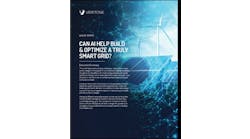Energy efficiency isn’t just about saving energy; nor is it just about improving comfort. It’s about aesthetics too, as evidenced by the growing number of beautiful LED lighting displays.
Check out, for example, the re-lit LED lighting installation on the San Francisco Bay Bridge, designed by artist Leo Villareal with equipment from Royal Philips.
Known as the Bay Lights, the project was first lit in March 2013 and was meant to be a two-year installation. It now will permanently illuminate the San Francisco Bay’s night sky.
Bay lights has 25,000 connected light points and an advanced cloud-based connected lighting platform to remotely monitor and maintain the lighting system, according to Philips. Overall, the project uses 4.5 miles of cable and 75,000 LEDs
“The original Bay Lights installation served as a major source of pride in San Francisco and helped to increase tourism in the area,” said Saeed Shahmirzai of Zoon Engineering, the Bay Bridge MEP integrator. “Thanks to advanced LED and system monitoring technology from Philips, we are able to build on those benefits and install an energy-efficient work of art that makes the Bay Bridge a true beacon of the San Francisco Bay Area.”
Meanwhile, on the other coast, Duke Energy is offering its own beautiful LED lighting display on a smaller scale. Multicolored lights will offer an artistic surprise to visitors along the 4.5 mile Charlotte Rail Trail, according to the utility.
A collaboration between Charlotte Center City Partners and Duke Energy, the project includes 12 LED floodlights, which are similar to those atop the Duke Energy Center. The lights have a full 360-degree rotation and a high lumen output of 8,500, similar to the output of outdoor parking lot lighting. The lights can display 16,000 different colors and have 13 programmable scenes that will change regularly to celebrate holidays, special events and more.
“Our vision is for the Rail Trail to be a zipper that connects people and neighborhoods,” said Chery Myers, senior vice president for planning and development at Charlotte Center City Partners. “This project represents the type of unique experiences we plan to curate across the length of the Rail Trail and is a remarkable example of what can be accomplished when the private sector and community stakeholders collaborate.”
***
But of course, lighting is not all about beauty. Getting more work out of each bulb remains the key. And U.S. Lighting Group says it’s doing just that.
In late January, U.S Lighting Group reported that independent U.S. test results show its LED clocking in at 158.64 lumens per watt. This makes it not only the longest-lasting LED bulb, but also the world’s most energy efficient LED commercially available, says the Ohio light manufacturer. USLG’s new LED light bulb is a four-foot bulb meant to replace the harsh fluorescent commonly found in offices, stores, and other commercial buildings.
***
Sensors often play a big role in lighting installations – as well as heating, ventilating, and air conditioning in buildings. So not surprisingly, the sensor market is growing. A new report by Navigant Research forecasts that global advanced sensor revenue will grow from $1.2 billion in 2016 to $3.2 billion in 2025.
The report examines the market for advanced sensors in six key segments, with global market forecasts for revenue and shipments, broken out by segment, customer sector, and region, through 2025. An executive summary is here.
***
In other energy efficiency news, Massachusetts looks determined to maintain its ranking as the top state on the annual scorecard produced by the American Council for an Energy Efficient Economy. State regulators recently approved the highest savings goal in the nation for Massachusetts utilities.
The Massachusetts Department of Public Utilities approved the 2016-2018 utility energy efficiency plans, which are estimated to provide $8 billion in economic benefits and energy savings. The programs have already delivered $12.5 billion in benefits since 2008.
The state aims to reduce electricity retail sales by 2.93 percent and natural gas sales 1.24 percent. The goal represents a 15 percent increase in electric savings and a 10 percent increase in gas savings over the state’s 2013-15 plans.
Massachusetts has topped ACEEE’s scorecard for five years running.
“Massachusetts’ energy efficiency programs are delivering on their promise to create large energy savings for consumers, and move the Commonwealth toward a clean, affordable and secure energy future,” said Daniel Sosland, Acadia Center president. “Efficiency is the best near-term energy strategy for reducing Massachusetts’ residents’ energy bills. Investing in energy efficiency produces immediate bill savings that persist for years to come.”
Check out how much Energy Efficiency Markets is growing on LinkedIn!





